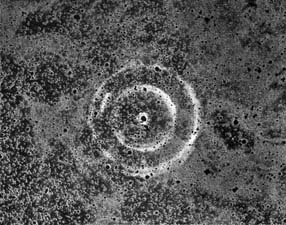Return to Index |
Next Image |
The explosion of Supernova 1987A was
witnessed by astronomers in February 1987, ejecting debris at a speed
of approximately six million miles per hour. The circles in this optical
image show light echoes, which appeared as the light from the supernova
explosion reflected off the pre-existing sheets of material in front of
the star. The reflected light took longer time to get to the earth and
so arrived after the explosion. Rings of gas surround the star. These
rings formed about 20,000 years ago, well before the star ever blew up.
At that time, the star was about twenty times more massive than our own
sun. The system was comprised of two stars orbiting one another. One of
the stars was large enough to become a red giant star, engulfing its smaller
companion. In this process, the star ejected some of its material in the
form of gaseous rings. The rings are illuminated by radiation emitted
from the explosion. Originally fading, one of the rings is now getting
brighter. It is thought that shock waves from the supernova are colliding
with one of the rings, and that over the next several years this collision
will heat the surrounding gas to millions of degrees, causing all the
rings to glow more brightly. Supernova 1987A is located approximately
180,000 light years away in the Large Magellanic Cloud galaxy.
(Copyright Anglo-Australian Observatory.)
References:
http://oposite.stsci.edu/pubinfo/captions/97-03a.txt
http://www.abcnews.go.com/sections/science/DailyNews/supernova0210.html
http://www.xs4all.nl/~carlkop/sn1987a.html
Object |
Distance from Earth |
Wavelength |
Supernova 1987A |
180,000 light
years |
Optical |

